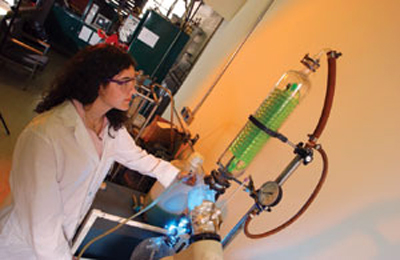 Building for success Building for success
by Alexandria Marder
|
|

"The curiosity that leads to the research and discovery that becomes a Nobel Prize begins in those laboratories and facilities that push young scientists to limits they don't know they have. World-class facilities attract world-class students."
 Robert Richardson '58; M.S. '60; Nobel Laureate/Physics Robert Richardson '58; M.S. '60; Nobel Laureate/Physics
|
XX |
Scholarly success at Virginia Tech is driving an institution-wide transformation that is changing the way the university looks and operates. Nowhere is this transformation more visible than in the new research facilities being built on campus. These buildings are being designed, staffed, and equipped to solve society's most complex problems and they are being built with help from private donors. While private giving has often been an important resource for capital projects at Virginia Tech, elevated support for the construction of new research buildings is now more important than ever.
Donor-established scholarships and professorships have long been important recruiting tools. Today, the best and brightest students and faculty also look closely at research facilities when choosing a place to live and work. These new buildings act as a powerful incentive to the talented individuals who will help to ensure Virginia Tech's future success.
|
|
|
One donor-funded research facility that has already attracted talented students and faculty is the W.C. English Geotechnical Laboratory, which opened in 2003 with the generous support of the W. C. English Foundation. Post-doctoral researcher Chris Meehan has spent many long days and nights in the lab--which is located off campus on Plantation Road--studying earthquake-induced landslides. The facility's spacious rooms, filled with new, specialized instrumentation, are a welcome departure from the basement of Patton Hall, where Meehan worked during his first few years of graduate school.
|
"We were pressed for space in Patton Hall," recalls Meehan. "Labs were used for both instruction and research, which is not ideal when running sensitive experiments. The new lab provides a lot of dedicated research space and has enabled the department to purchase some really sophisticated equipment. Any geotechnical researcher would be thrilled to work here."
With new research space and room to grow, the geotechnical engineering department has been able to attract star faculty members and tackle bigger research projects. For instance, two faculty members who are among the top geotechnical engineers in the world are analyzing projects for the U.S. Army Corps of Engineers, including the design and construction of levees to replace those that failed after Hurricane Katrina. The new lab has helped to elevate Virginia Tech's geotechnical engineering program, making it one of the best of its kind in the country.
John Rocovich (business '66) and his wife, Sue Ellen (Ph.D. genetics '76), are dedicated Virginia Tech volunteers and donors who understand the importance of modern research facilities. "You can't do cutting-edge research on the Drillfield," John says. "You've got to have high-quality bricks and mortar and create stimulating environments where faculty can do their fine work and prepare students to change the world for the better." The Rocoviches are supporting the construction of two new research facilities that will house the Institute for Critical Technology and Applied Science (ICTAS). Here, researchers will build on Virginia Tech's strengths in computational and life sciences and focus on new initiatives in certain growth areas, such as information technology and biomedical engineering, that will cement the university's position as a leader in these fields.
|
XX |
Planned research buildings
Institute for Critical Technology
and Applied Science II
Sciences Research Laboratory I
Infectious Disease (NIH)
Research Facility
Engineering/Computational Sciences
Research Facility I
Life Sciences Research Facility II/
Translational Medicine
Sciences Research Laboratory II
Natural Resources/Sciences
Research Laboratory
Engineering/Computational Sciences
Research Facility II
Architecture Research Facility
|
|
Research facilities like ICTAS and the W. C. English Geotechnical Laboratory demand advanced instrumentation that may require a lot of space, energy, and security. Bob Broyden, the university's director of capital assets and financial management, says that most existing campus buildings are inadequate, even with significant renovation, to accommodate the rapidly changing technologies required for groundbreaking discovery and innovation. Many have physical limitations, such as ceilings that are too low for large pieces of modern equipment or foundations that are not stable enough to minimize vibration--a major consideration in precision research.
New research facilities are being designed with the latest in security, air handling, and electrical systems that are powerful enough for modern research environments. The capacity to move forward with these modern facilities is critical to the future success of our research programs. The new buildings will also be more flexible than older facilities, with modular laboratory layouts to allow for changes in the space needs of investigators and to foster more interactions among scientists from different fields.

 Chemistry/Physics Building Chemistry/Physics Building
Historically, funding for research space has been shared by the state and the university, but the buildings that Virginia Tech researchers need require a level of funding that the state can no longer be completely relied upon to provide--particularly when those appropriations have become increasingly unpredictable. Without adequate state funding, the university must use valuable overhead funds that could otherwise support operational costs for research programs. Recently, private donors have stepped forward to support new facilities; as a result, the university has been able to expedite some of its building projects.
"We have nine new research buildings planned for the future to provide about 660,000 square feet with an estimated total construction cost of $293 million," explains Broyden. "Based on the lessons we've learned about the power of private support to accelerate projects, we believe that achieving the university's building element of our research aspirations is positively tied to charitable giving."
Over the years, charitable giving to Virginia Tech has been key to providing the tools that students and faculty need. Their accomplishments, together with the generosity of such donors as the English and Rocovich families, have made Virginia Tech the success it is today. With private support for modern, well-equipped facilities, Virginia Tech will be able to expand and advance work on crucial issues, creating new knowledge and making discoveries that will have a profound impact on communities around the world.
 Alexandria Marder is special projects editor for the Office of University Development. Alexandria Marder is special projects editor for the Office of University Development.
|
 Hatcher legacy supports future inventions Hatcher legacy supports future inventions
by Judith Davis
|
|
Inky and Betty Hatcher would be amazed.
How do you pack a structure longer than three football fields into a rocket cargo bay the size of an SUV? By using applied mathematics and smart materials to collapse the huge object and load it on board. Released in space, the object then inflates and becomes rigid, dwarfing the craft that transported it.
That's just one way Virginia Tech's Interdisciplinary Center for Applied Mathematics (ICAM) is inventing the future. And the Hatchers are helping.
 |
XX |
A quiet VPI math professor born before the Wright Brothers' first flight, Thomas Watkins "Inky" Hatcher (mechanical engineering '22) and his wife, Betty--who passed away in 1979 and 2001, respectively--seemed an unlikely pair to help send tomorrow's technology into orbit. Or to help battle cancer. Or to use supercomputers to fight bioterrorism and predict the path of pandemic disease.
But that's exactly how the Hatchers are today helping at ICAM. There, T. W. Hatcher Professor of Mathematics John Burns is part of a team of researchers turning science and engineering theories into revolutionary technology.
|
A generous couple who enjoyed a mental challenge, the Hatchers would be fascinated--and deeply pleased--to see the power of their legacy at work.
"Funding provided by endowed professorships makes a critical difference in the ability to pursue priority research," says Burns. He was named the Hatcher professor in 1995, shortly after Mrs. Hatcher endowed the chair in her husband's memory.
Burns and other ICAM researchers use applied and computational mathematics to tackle challenges that come in all shapes and sizes, from large space structures to microscopic viruses to malignant growths.
|
"As amazing as it may seem," says Burns, "the equations describing one area of science often turn out to be similar to [those] needed to predict behavior in a seemingly unrelated area. The mathematics used to predict how air flows over the wings of a tiny micro-airplane is similar to [that] needed to understand and control the immune response to cancer cells."
Burns and his colleagues also create equations to predict the deadly path of a bioterrorist's dirty bomb or the spread of a global epidemic.
Such results would have been particularly satisfying to Inky Hatcher, who, as a young cadet, saw the 1918-19 flu infect one-fifth of the earth's population.
Hatcher joined Virginia Tech's faculty in 1924 and served as mathematics department head from 1943-63. During his tenure, the first B.A.'s in mathematics were awarded and the department's M.A. and Ph.D. programs were created.
"[Hatcher] loved his school, loved his work, and loved his teaching," says his former colleague and friend, Hugh Campbell, "and Betty was clearly devoted to him."
|
XX |

 Hatcher Professor Hatcher Professor
John Burns
|
The Hatchers' estate gifts underscored their lifetime commitment to Virginia Tech. All told, their contributions--primarily scholarship and faculty support--exceeded $2.2 million.
The impact of that legacy, both financial and personal, grows exponentially. Over time, the endowments have provided increasing monetary support. And in addition to Hatcher's and Burns' students, hundreds of Hatcher Scholarship recipients touch countless lives through their own teaching and research.
Young T. W. Hatcher was dubbed "Inky" by fellow cadets because a hatcher is an incubator--an apt soubriquet for a man whose generosity, along with that of his wife, is helping provide an environment where new ideas are born.
To learn how you can make an estate gift to Virginia Tech, call the Office of Gift Planning at 800/533-1144 or e-mail giftplanning@vt.edu. Visit our website at www.givingto.vt.edu for sample bequest language and other information about charitable giving.
 Judith Davis is a publications editor in the Office of Gift Planning. Judith Davis is a publications editor in the Office of Gift Planning.
|
|

